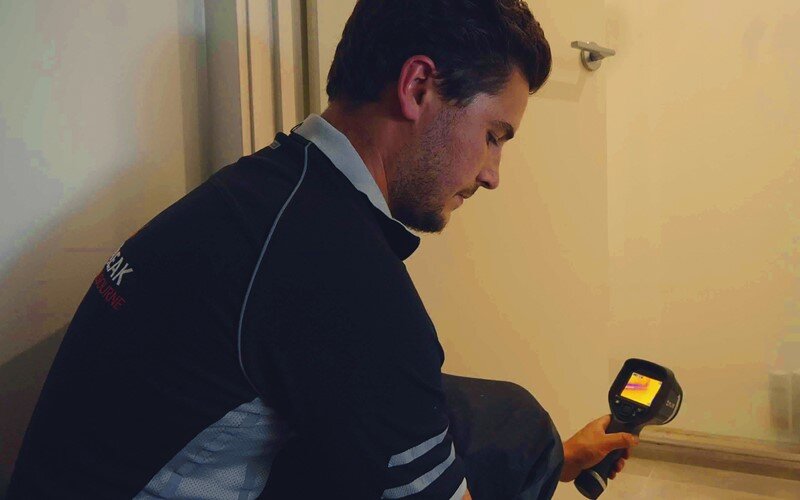6 Ways to Locate Concealed Water Leaks in Your House
6 Ways to Locate Concealed Water Leaks in Your House
Blog Article
This article in the next paragraphs in relation to Leaking water lines is fairly attention-grabbing. You should look it over.

Early discovery of leaking water lines can mitigate a potential calamity. Some little water leaks might not be visible.
1. Check Out the Water Meter
Every residence has a water meter. Examining it is a guaranteed way that helps you uncover leakages. For starters, switch off all the water resources. Guarantee no person will certainly purge, make use of the tap, shower, run the cleaning equipment or dishwasher. From there, go to the meter and watch if it will change. Because no one is using it, there need to be no movements. That shows a fast-moving leakage if it moves. Also, if you find no changes, wait an hour or two and also examine back once more. This indicates you may have a slow leakage that might also be underground.
2. Examine Water Consumption
If you find unexpected adjustments, despite your usage being the exact same, it suggests that you have leakages in your plumbing system. A sudden spike in your expense suggests a fast-moving leakage.
Meanwhile, a stable boost on a monthly basis, even with the same routines, reveals you have a slow-moving leakage that's additionally gradually intensifying. Call a plumber to thoroughly inspect your residential property, especially if you feel a cozy location on your floor with piping beneath.
3. Do a Food Coloring Test
When it concerns water consumption, 30% originates from bathrooms. Examination to see if they are running correctly. Decrease flecks of food color in the storage tank and wait 10 mins. There's a leak between the container and bowl if the shade in some way infiltrates your bowl during that time without flushing.
4. Asses Outside Lines
Don't neglect to check your outdoor water lines too. Must water seep out of the link, you have a loose rubber gasket. One small leakage can lose heaps of water and also increase your water costs.
5. Analyze the circumstance and also examine
Homeowners should make it a behavior to check under the sink counters as well as also inside cabinets for any type of bad odor or mold and mildew growth. These two red flags indicate a leakage so prompt focus is required. Doing routine examinations, even bi-annually, can save you from a significant issue.
A lot more significantly, if you recognize your residence is currently old, keep a watchful eye on your heating systems, pipes, pipelines and so on. Check for stainings and also damaging as many home appliances and also pipelines have a life expectancy. They will likewise naturally weaken as a result of tear and use. Do not wait for it to rise if you believe leaking water lines in your plumbing system. Call an expert plumber right away so you do not end up with an awful mess in your home.
Early detection of dripping water lines can minimize a possible catastrophe. Some small water leaks might not be noticeable. Inspecting it is a guaranteed way that aids you uncover leaks. One tiny leakage can throw away heaps of water as well as surge your water bill.
If you believe dripping water lines in your plumbing system, don't wait for it to rise.
WARNING SIGNS OF WATER LEAKAGE BEHIND THE WALL
PERSISTENT MUSTY ODORS
As water slowly drips from a leaky pipe inside the wall, flooring and sheetrock stay damp and develop an odor similar to wet cardboard. It generates a musty smell that can help you find hidden leaks.
MOLD IN UNUSUAL AREAS
Mold usually grows in wet areas like kitchens, baths and laundry rooms. If you spot the stuff on walls or baseboards in other rooms of the house, it’s a good indicator of undetected water leaks.
STAINS THAT GROW
When mold thrives around a leaky pipe, it sometimes takes hold on the inside surface of the affected wall. A growing stain on otherwise clean sheetrock is often your sign of a hidden plumbing problem.
PEELING OR BUBBLING WALLPAPER / PAINT
This clue is easy to miss in rooms that don’t get much use. When you see wallpaper separating along seams or paint bubbling or flaking off the wall, blame sheetrock that stays wet because of an undetected leak.
BUCKLED CEILINGS AND STAINED FLOORS
If ceilings or floors in bathrooms, kitchens or laundry areas develop structural problems, don’t rule out constant damp inside the walls. Wet sheetrock can affect adjacent framing, flooring and ceilings.
https://www.servicemasterbyzaba.com/blog/how-to-detect-water-leakage-in-walls/

Do you like reading about Detecting hidden plumbing leaks? Make a remark below. We will be delighted to see your suggestions about this write-up. We are looking forward that you visit us again soon. Do you know about somebody else who is looking into the niche? Please feel free to promote it. Thanks for going through it.
Report this page